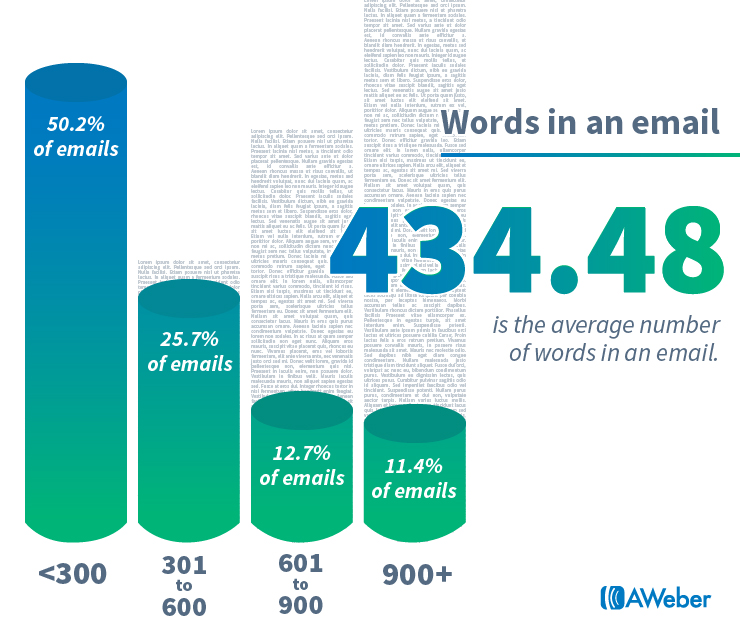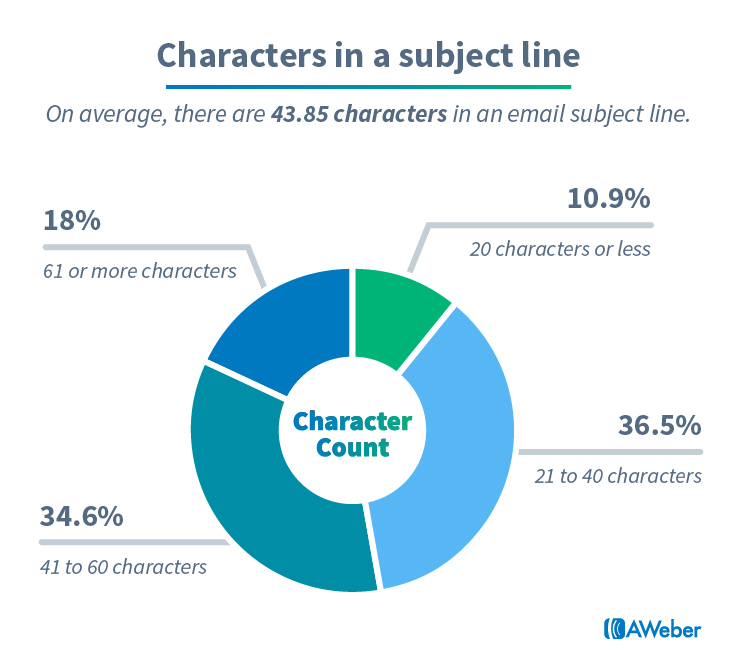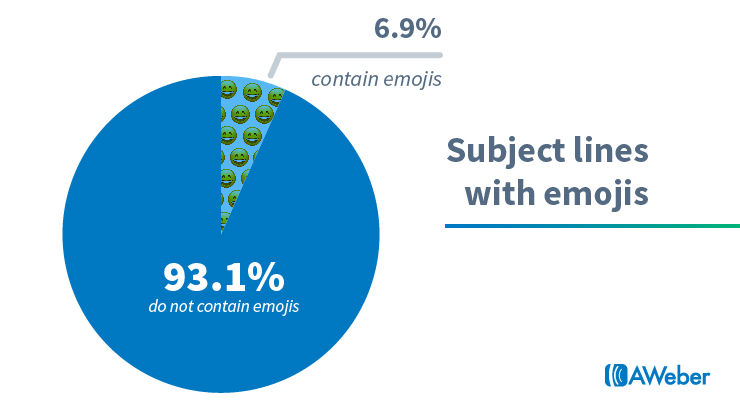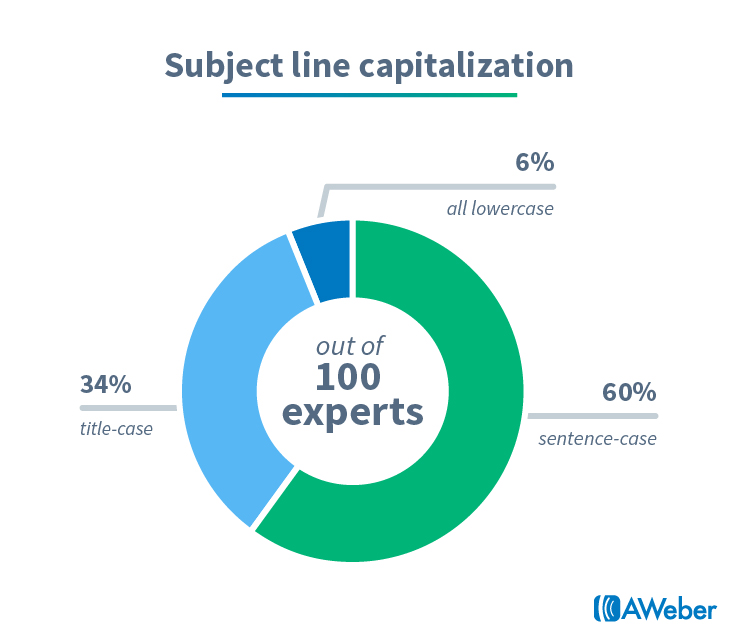2019 Email Marketing Statistics: We Analyzed 1,000 Emails from Today’s Top Experts

- How many words are in an email?
- How many characters are in a subject line?
- What percentage of subject lines include emojis?
- How do experts capitalize their email subject lines?
Want to skip to a specific section? Click on one of the questions above.
Email marketing statistics: Words in an email
The average email length
Of the 1,000 emails we analyzed, we found that emails have 434.48 words on average. 434 words takes approximately 3.3 minutes to read.
Why some pros go with shorter emails
However, more than 50% of the emails we analyzed contained 300 words or less (a 2.3 minute read time). With people receiving more emails than ever before, it makes sense that experts are sending shorter emails. Email marketers need to stand out to captivate their readers. Short emails might be a good strategy for doing so. Henneke Duistermaat is the founder of Enchanting Marketing and one of the 100 top marketers whose emails we analyzed. She often sends emails with less than 300 words. “Have you ever heard someone complaining they're not getting enough email?” Duistermaat said. “Everyone’s inbox is overflowing. We’re all time-starved. So, we love succinct messages that help us make a quick decision: whether to reply or not, whether to click through or not.”Why some pros send long-form emails
Yet, 24.1% of the emails we analyzed contained 601 words or more. And 11.4% of them had more than 901 words, a read time of approximately 6.9 minutes. These experts stand out by sending long emails packed with valuable content, like Ann Handley. Handley is the Chief Content Officer at Marketing Profs, a marketing education company, and one of the top 100 marketers we included in our research. She sends her newsletter TotalAnnarchy via AWeber every other Sunday. On average, her newsletters contain 1,838.5 words, which takes roughly 14 minutes to read. Handley said, “It's not that long-form emails are effective. Rather, what's effective is emails that have value for the people on your list. I don't set out every other Sunday with a goal of writing the longest email I possibly can. But I do have a goal of writing an authentic, valuable, fun letter to each and every subscriber on my list. I put my heart and soul into it, and that's why people respond.” Matt Kepnes, author and founder of travel blog Nomadic Matt, is also on our list of top marketers. He sends long-form emails as well. On average, they contain 802 words. Instead of linking off to posts on his blog, he includes entire articles within his emails. These messages see high open and click-through rates. “People will read longer emails if the topic is important enough," Kepnes says.How to choose your email length
So how do you decide whether to send short or long emails? It depends on your unique business goals, according to Andy Crestodina, a top email marketer and the founder of website consulting company Orbit Media. “If your goal is simply awareness, long or short is less important. If subscribers see it, like it, and smile, you met the goal! If your goal is traffic, then give the recipient the minimum amount of information needed to decide to click. The CTR (click-through rate) is everything and more text just means more noise in their inbox.”
Email marketing statistics: Characters in a subject line
The average character count of a subject line
Email subject lines play a huge role in whether your messages get opened. In fact, 47% of email recipients open email based on the subject line alone, according to research done by Business2Community. After researching 1,000 subject lines, we found that email subject lines have 43.85 characters on average. 82% of experts send subject lines with 60 characters or less. Which makes sense considering most desktop email clients, such as Gmail and Yahoo!, only display approximately 60 characters before a subject line gets cut off.
82% of experts send subject lines with 60 characters or less. Which makes sense considering most desktop email clients, such as Gmail and Yahoo!, only display approximately 60 characters before a subject line gets cut off.
Why you should consider using short subject lines
46% of emails are opened on mobile devices, according to research conducted by email testing service Litmus. So it’s important to consider how mobile devices affect the ideal subject line character length. Most email clients stop displaying an email subject line on mobile devices once it reaches between 33 and 43 characters. The exact number varies from one email client to another. Since they don't get cut off in the inbox, shorter subject lines may outperform longer ones. And because only 10.9% of subject lines contain 20 characters or less, it may also be an opportunity to stand out. Brian Dean, founder of SEO company Backlinko and one of the 100 top marketers whose emails we analyzed, sends subject lines with an average of 15.1 characters. “After lots of testing I've found that short subject lines get much higher open rates,” Dean said. He believes these results are due to two factors:- Short subject lines reach the inbox more frequently.
- Short subject lines are more mysterious.
“I used to try to outline the entire message in my subject lines. And it gave people no reason to actually open my email,” Dean says.
Email marketing statistics: Emojis in subject lines
The percentage of emails with emojis
Only 6.9% of the 1,000 email subject lines we analyzed incorporated emojis. That leaves a whopping 93.1% of subject lines without them.
Why only 6.9% of emails contain emojis
Experts might see emojis as a risk, since they can display differently, and sometimes incorrectly, in email clients. In fact, subscribers opening emails on old computer operating systems may not see emojis at all. “Windows 7, which holds a major market share of 48.4%, offers very limited support for emojis, displaying in black and white or not at all,” email testing company Litmus says in its research on emoji support in email. [caption id="attachment_88494" align="aligncenter" width="800"] [Image source: Litmus][/caption]
[Image source: Litmus][/caption]
Why you should consider using emojis in your subject lines
While only 6.9% of subject lines included emojis, that doesn’t mean you shouldn’t. In fact, this may mean you should test them with your own audience. It could be a huge opportunity to be unique. And emojis might actually increase open rates — as long as you use the right emoji, according to Mark Asquith, marketing expert and founder of Rebel Base Media. (Asquith is one of the 100 top marketers whose emails we included in our research.) He frequently uses the icons in his own subject lines. “A well-placed smiley, timer, or contextual emoji used alongside a well-thought-out subject line will really make your message stand out within someone's already very busy inbox,” he said.Try a/b split testing two email subject lines — one with an emoji and one without. The results from your split test can help determine if emojis boost open rates with your own audience.
Related: How to Split Test Your EmailsEmail marketing statistics: Subject line capitalization
The 3 capitalization formulas for email subject lines
To find out how top marketers use capitalization in their email subject lines, we examined the subject lines from our 100 experts to see if they relied on a particular capitalization formula. We found 3 common formulas: sentence-case capitalization (the first letter of the first word is capitalized), title-case capitalization (the first letter of every word is capitalized, except for articles like “the” and “an”), and all lowercase capitalization (every letter is lowercase). As an example, here is the same subject line with these 3 different formulas applied to it:- Sentence-case: This is an email subject line
- Title-case: This Is an Email Subject Line
- All lowercase: this is an email subject line
How experts capitalize their subject lines
60% of email subject lines use sentence-case capitalization, 34% use title-case capitalization, and only 6% use all lowercase email subject lines.
Are lowercase subject lines an underused secret?
The majority of the experts we analyzed use sentence-case capitalization. But a few experts consistently send emails with entirely lowercase subject lines, like email marketing expert Val Geisler. Geisler is a freelance consultant and writer who specializes in email marketing, and we analyzed her emails for our research. Geisler points out that people are more likely to open an email if it’s from a personal connection or friend. “If you're writing an email to a friend, are you going to title-case the subject line? Probably not. You likely won't even use sentence-case capitalization," she said.“I write my emails like I'm writing to a friend so my subject lines follow the same principles. Does it work? I'll let my ~80% open rates and ~30% click rates speak for themselves.”How should you use these email marketing statistics?
Use these findings as a guide the next time you’re writing an email. Want to stand out? Try a strategy that most people aren’t using — like emojis in subject lines or lowercase subject lines. Want to follow a proven strategy used time and again by the experts? Use the findings in this report to follow time-tested email copy strategies used by the majority of experts. To receive more research like this, as well as free email marketing advice and strategy, subscribe to our weekly email newsletter FWD: Thinking.About the data from this research
We analyzed 1,000 marketing emails from 100 successful businesses and entrepreneurs. While we didn't randomly select these businesses, we chose experts across multiple industries and from numerous countries. See the complete list of the 100 businesses we included in our research (and follow them!) here.The post 2019 Email Marketing Statistics: We Analyzed 1,000 Emails from Today’s Top Experts appeared first on Email Marketing Tips.
from Email Marketing Tips http://bit.ly/2AFDMMO
via
No comments